#lots of swoopy lines
Text
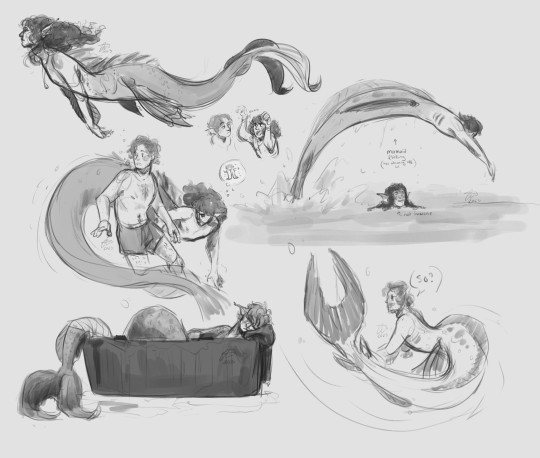
im a whole week late, but heres a mermay sketch dump of steddie
#the top one of eddie is my absolute favourite and it was very soothing to draw#lots of swoopy lines#mermay#no id#my art#i also do plan to draw more mermaids tomorrow#im not good at sticking to time limits#eddie munson#steve harrington#steddie#steddie fanart
670 notes
·
View notes
Text

other loose things that were on that one mspaint canvas i shared art from a little while ago ....... ohoh ! ohoh ! he has sticks for arms because he suuuucks
#if you spent a day in my life you would come to learn how incomplete and silly a good lot of my doodles are#which well ... duh ! but its also like come on. is anybody gonna finish drawing the rest of these characters hair? or arm?#gesture is something i specifically would like to study and i consider a lot of my art to lack that kind of naturalistic essence#/energy which makes A little sense considering something i really love in art and aim for is very specific posing and 'intentional stiffess#like the type you may find in very stylized fairytale/folk art !#so it is very silly when i get to doodling and a lot of it is very swoopy lines and gestural ideas#it varies#i do love some delightful lineart and want to actively push towards achieving a certain look with it#but ive also really loved doing way more loose stuff lately.#and when it comes to said loose/gestural artwork i can never turn it into a ''finished'' piece#should get around to collecting and putting more of that onto my art blog as is ....!#the length of his cloak varies depending on what the drawing calls for#my rambling oh dont look too closely .!! ahh !!
13 notes
·
View notes
Text
"The Elliot." My final comic for my comics class. Four more pages under the cut. Thank u for reading <3
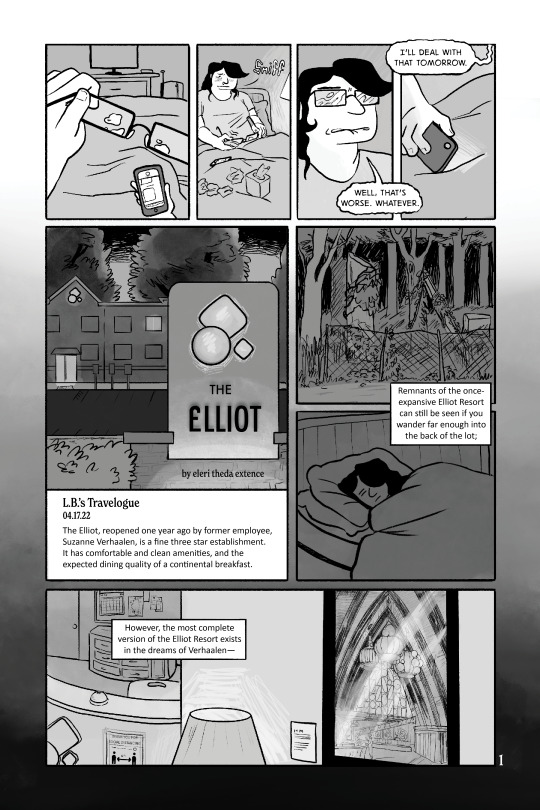
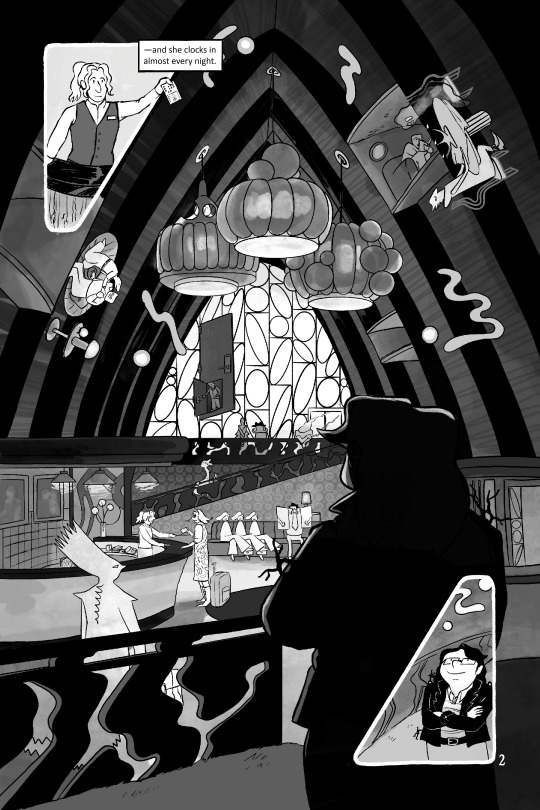




#comics#my art <3#I was going to write#“architecture and interior design nerds please do not come for me”#but please do actually if you have corrections or suggestions#the research was so hasty for this if I ever expand on this story I would want to do a lot more architecture/interior design research#the splash page of the lobby is based on the 1960s lobby of the Coco Palms Resort#and I think the plot line of it partially burning down is from that as well#I think the coco palms resort itself is not “googie” but I thought the architecture was swoopy enough to be googie-adjacent lol#hotel bennet#I don't really want to call this series hotel bennet anymore but im tagging it that for consistency#new tag will be L.B. Travelogue#If I ever use this tag again lol#or Bennet Travelogue? idk#motel#hotel#dreams#dreamscape
3 notes
·
View notes
Photo

⚔️ Hi-yah! Art Attack for @fletchier of their character Lyra!
#art fight 2022#art fight#obby art#fletchier#toonkind#lyra#other's ocs#friend's ocs#lyra is very fun to draw!!#lots of swoopy lines and fun shapes#UPA style toons are always a fun challenge
18 notes
·
View notes
Photo

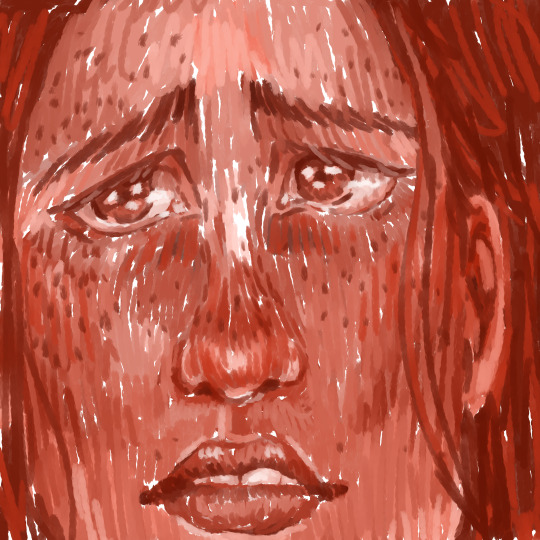

here, have some quick airplane sketches
#i don't get to draw a lot anymore#mostly due to mental blocks and feeling inadequate etc etc etc#but#drawing on airplanes with big swoopy lines and brushes#and blame turbulence for mistakes#really helps#too bad i only fly like once a year#anyway#shout out to the man who stood behind me for the whole of the green and little for the peach#i thought you were just waiting for the bathroom#but you sure did let people cut in front of you a lot#my art#digital art#sketches#excuse me that they all look pretty much the same#im not good at imagining faces#in fact#after the blue one#i completely forgot what faces looked like at all#and simply had to stop drawing because all the subsequent sketches were actually embarrassing
1 note
·
View note
Text
YOURS TO KEEP.

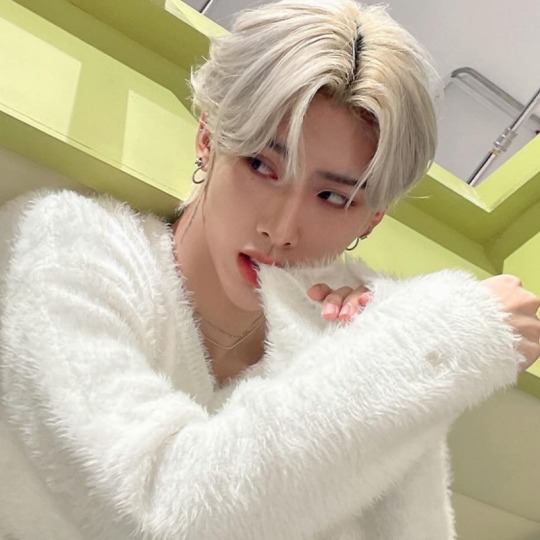

p — SHEN QUANRUI x female! reader. g — college! au, exchange student! ricky, fluff, very very lightly angsty. w — swearing, alcohol consumption. kdrama references and misquoted quotes. 3.2k words.
note — dreamt of ricky. vomited out.....ricky as ur cute bf who behaves like a cat and whose favorite forms of cross-cultural exchange is receiving headpats and watching kdramas. only 2 scenes are actually inspired by my dream 😭 if someone guesses which line/s were extracted directly from my dream, i'll reward u with a gyuvin drabble how about that 👍

you picked up a cat from the university’s foreign exchange program.
however, he did not come in a box. he came in a louis vuitton tracksuit and balenciaga sunglasses, which very much caught you off guard when you came to meet him at the admin building, and you greet him after mustering the courage to finally walk up to the cat’s imposing presence. “h—hello! are you perhaps shen quanrui?”
he takes off his sunglasses, meets you with a pair of pretty swoopy, pretty eyes, and says, “oh. yes. are you my owner?”
you pause. you’re taken aback because that...that doesn’t sound like the right word. “ah, um. i’m the person assigned to help you around the campus and the city for the semester, yes! it’s nice to meet you!” but you brush it off because of language barriers and all. his mouth falls into an ‘o’ shape when you tell him the correct term.
“oh, sorry.”
“it’s alright!” you say. “hope we get along!”
quanrui tells you that you can just call him ricky, and gives you a small smile. one of many that you’ll be graced with for the duration of the semester.
“i’ll be in your care.”
your new cat is a little intimidating at first, clad in all black at all times. the night you helped him first settle into his dorm, even his pajamas were reminiscent of an abyss— like a white ragdoll trying to disguise itself as a panther because you later find out that he’s actually a really sweet, really polite, and really clingy cat.
“um. knock, knock.”
you look up from your laptop, ricky in a long leather coat hesitantly peeking out from your half-open bedroom door (you gave him a copy of your apartment key. your cat needs a way to get in by himself somehow). he texted you earlier, asking if you can help him out with an essay, and you assume he’s right here right now for that very reason.
“do you have your paper?” you ask, closing your laptop. he nods and lifts up his ipad, showing it off. you have a very cute cat. you scoot aside and pat the empty space on your bed, and ricky comes padding in, mattress sinking when he settles beside you, making sure to maintain a respectable enough distance and hands you his device with the google doc open.
“oh. i marked the parts where i’m not sure about my vocabulary,” he mentions the moment a yellow highlighted part came up on the screen.
you give it a once over. “i think this is right. yeah, you did good.” when you turn your head, you’re met with a pair of proudly sparkling eyes. you stifle out a laugh. “what? do you want a head pat for that?”
“maybe i deserve one?”
you let your fingers sink into the fluff on the top of his head. again, he’s really sweet, really polite, and really clingy. but maybe a little too clingy sometimes, especially when he finally got a lot more comfortable around you.
comfortable enough to hiss at your friends.
“oh, you signed up as a student-helper for the exchange program too?” hanbin asks after seeing you walk in the classroom with ricky in row, trailing behind you like a shadow.
“yeah, i can’t miss the extra points prof choi baited us with.” you nudge ricky with your elbow, noticing how tense he is all of a sudden and how he’s looking at your senior with a bit of a glare. perhaps he’s threatened by another feline presence.
“nice to meet you!” hanbin greets with a bright, an arm outstretched before you, meant for ricky, but he keeps tucking himself behind you with his hands fixed on your shoulders.
hanbin has his hand left unshaked for five seconds too long now. you nudge him again. he won’t budge.
“ah, ricky is still a little shy!” you exclaim, trying to salvage the situation by grabbing hanbin’s hand instead with both of yours, swinging it around, left and right. you’re lucky your senior is so easygoing. he laughs along with you and says of course, of course, he totally gets it, merrily swinging your arms together back and forth. “he’s still not that confident with his korean. right, ricky?”
“keep holding her and i’ll claw your eyes out.”
you freeze. you leer back at ricky shen, giving him your what the fuck are you saying look? he maintains his stance, tugging you back by the shoulders. you twitch out a smile and try your best to defend your clingy and jealous cat. “ahaha. he’s picked up some weird things from all the dramas he’s been watching,” you say. “sorry about that seonbae! we’ll get to our seats now!”
“haha, it’s alright! nice to meet you ricky!”
“what was that?”you snap back at him the moment hanbin leaves the premises. all ricky does is shrugs and steadies his hold on your shoulders, aiming your body somewhere and he starts making you walk to the back of the classroom— far, far away from where hanbin is sitting.
your cat is a little weird sometimes, sure. gyuvin finds him entertaining enough though. they play tennis every weekend, and ricky started picking up even more weird things from him and all the rest of your friends that you’re starting to think they’re not very good influences.
case in point—
“if you drink this, we’re dating.”
the grape juice he poured into your paper cup nearly spills over from shock. you look at him, eyes wide and brows furrowed, cheeks burning and heart racing because what the hell? “seriously, where have you been learning these things?”
ricky looks satisfied for eliciting that kind of reaction. he pours himself a paper cup of grape juice as well because it’s a weeknight, and you have a quiz tomorrow, and getting wasted is off of the table, so you two settled for juice and chips on your living room floor to relish in your academic misery.
“jiwoong hyung and gunwookie recommended me some movies for me to watch.” he sets down the juice bottle after screwing the cap shut, and you fear the other movies those two gremlins recommended him come from a list of top 50 movie pick-up up lines to woo an unsuspecting victim. next thing you know, he’s gonna invite you to have ramen at his place or go see freaking butterflies with him. “i just watched a moment to remember earlier. my pronunciation is getting better, right?”
ricky is looking at you with his eyes all big and his lips all pressed together expectantly. he’s waiting for your praise. you feel your chest swell. the grape juice feels heavy in your hand. gosh, he’s such a needy cat. a needy cat that deserves all the praise in the world.
“yeah. i’m proud of you. c’mere.”
you leave your cup on the table to focus on more important things— that is, giving ricky his well deserved pats on the head. you don’t recall how your relationship with him managed to get this far, still remembering how intimidated you felt when you first met him. now he’s on your living room floor, head laying back on your couch with a drama playing on the tiny laptop screen settled on the coffee table, both of you barely paying attention because he’s looking at something on his phone, and you’re gently rubbing his head as you reply to some messages on yours.
“ah, gyuvin is seriously annoying,” you complain. “he’s trying to get me to join his club. coding club he says, when i’m pretty sure he’s just starting it as an excuse to play games on campus.”
“are you going to join?” he asks, bumping his head against your palm when you stop giving him scratches.
“mm, i don’t think so.” you set down your phone to pour all your focus into satisfying your needy cat’s attention requirements. ricky lets out a satisfied rumble when set his head down onto your lap, raking your fingers through the tufts of his hair as he lets his eyes flutter to a close. “i’m already too busy this semester to bother with those things. maybe next time if he’s that desperate to fill in the member numbers..”
“yeah,” he mutters. “you’ll be too busy spending most of your time with me.”
your fingers stop moving.
ricky looks up at you, confused as to why you stopped petting him, and you’d eat him right up if you could. but you can’t keep your cat for too long. it’s only a matter of time before you get your last opportunity to coddle him like this, to shower him in unabashed affection disguised as friendship because the exchange program is temporary, and he’s returning back to china at the end of the semester.
so why is he raising your hopes up if he’s just going to leave anyway?
“i meant my acads, silly,” you say, picking up your untouched juice cup from the table, feeling the weight of the drink slosh around the paper cup as you let it hover in front of your lips.
he’s raising your hopes up and you’re letting him. you know this is gonna end in a disaster.
still.
“but if you put it that way—”
the sharp taste of sweet grapes hits the back of your throat, swallowing down the lukewarm juice that’s been sitting since ricky poured a cup for you. if you’re gonna crash down at the end of this, might as well crash down from two thousand feet above the ground.
“are we dating now?”
you set the cup back down on the table, gaze flickered down at ricky, whose face is flushed in surprise one moment— easing into understanding the next, and he props himself up from your lap, reaching out for the back of your neck to pull you into a sugary tart kiss.
yeah, you think, feeling the softness of his lips brush against yours, his eyelashes tickling your cheeks when he pulls you in even closer. if your time with him has a deadline, might as well make the most out of it.
“i was disappointed when you didn’t drink it the first time,” he says, drunk on sweet juice and the feeling of your mouth against his. “jiwoong hyung said that line was effective.”
“can you not think about another man when i’m kissing you?”
he lets out a laugh, “‘m sorry,” then presses a fluttering kiss on your temple, tip of your nose, until his lips meet yours once more at last. “let me try again. ahem. i like you. i don’t need a rainbow.”
“you got the line wrong, baek yijin. try again next time.”
if he’s going to leave anyway, might as well make his departure as heart wrenching as all the dramas he’s so fond of watching.
“looks like our friend here got more than just extra credit for volunteering to help out the exchange students.”
you look up from the stack of papers on your table, only to have more dropped off by taerae with a thunk. hanbin, gyuvin, matthew and ricky are also loitering around the classroom— not that they’re helping you and taerae check the test papers your profs asked you to grade as a favor. at least the constant yelling and arguing and meowing noises(?) are making things a lot more lively.
“congrats, you lucky bitch,” he says.
“you sound like you want to covet my cat,” you raise a brow at him, adding the new set to your pile as taerae grabs a new stack as well.
“your cat for this mutt,” he points his thumb at matthew, who’s currently tucked in the to answer an evaluation sheet on taerae. ricky’s doing the same evaluation about you, somewhere. you’re not sure where your cat went, but he’s probably just around. “are you perhaps open for negotiation?”
“matthew isn’t a mutt. he’s a cute golden retriever.”
“well, your cat doesn’t seem to appreciate you calling someone else cute.”
taerae swerves off to reveal a pouting ricky. he’s got his arms crossed, the evaluation sheet folded in between the fingers of his right hand, and you have to hold back a laugh. “did you finish my evaluation?” you ask.
“i did, but i wanna redo it now. negative points for you,” he protests, but lets you snatch the paper from him anyway. you scoot your chair to the left to give him some space next to you. he grabs an empty armchair and nudges his nose close to your face when you start reading his note at the bottom.
“mid-semester evaluation. my student-helper is very acommodatimg. she has been helping me adjust to korea very well. you spelled accommodating wrong, angel.”
“i did it on purpose to test you. good job. you pass.”
you roll your eyes, free hand absentmindedly reaching out for the top of his head, and you hear ricky let out a noise of satisfaction. “she always answers my questions and is…very pretty and smells nice,” you set the paper down. your cat is looking at you expectantly. “ricky, i don’t think you can submit this.”
“why not?” he asks. “professor choi said to be as honest as possible.”
your cheeks grow warm.
gosh. this makes things even harder knowing your cat has to leave eventually.
“what did i tell you?”
the convenience store lights need to be replaced soon, you note. it keeps flickering intermittently against the dim night— reminiscent of how you’re feeling right now when you called jiwoong out for a few drinks two weeks before finals, but you’re not depressed because finals are near. you’re wallowing in tear stained sniffles because the exchange program will be over soon, meaning you only have two weeks until ricky has to pack his bags and leaves.
“not to get too attached because he has to say goodbye eventually,” you lament, a puddle of soju burning your lips. jiwoong looks at your pathetic state with remorseful sigh.
“and what did you do?” he says.
“got too attached and now i have to say goodbye to him eventually.” you groan and swallow down a shot. you’re about to pour yourself another, but jiwoong pulls back the bottle— maybe your third one of the night, you’re not sure— away from your reach, and pushes you a plastic bottle of water instead.
“you just had to go ahead and start dating him like an idiot,” he cracks open the water for you when you don’t do anything with it. he pours it in a shot glass, and you take the bait, drinking down the water, eyebrows furrowing when it doesn’t burn your throat like you expected. “maybe if you tell him to say, he might listen to you.”
you let out a gasp. “i can’t do that! that’d be so selfish of me!”
jiwoong can’t do anything to help you but share your miseries tonight. he simply sits in silence, waiting for the owner of the number he texted a while ago to make an appearance, and listen to your drunk ramblings at eleven in the evening.
“i miss my cat. i haven’t seen him the entire day because he says he had things to do with hanbin and hao.” you’ve melted into the table. high pitched whines aside, he’s surprised you’re still coherent at this point. “bring me back my cat. i miss him so much. i miss my cat. i miss my ricky. i wish he’d never leave me.”
jiwoongs eyes flit up. “looks like your cat misses you too.” he pulls himself up from his chair and picks up his jacket from the backrest. “took you long enough.”
when you tip your head back in confusion, wondering who the hell jiwoong is talking to, you’re pleasantly surprised to see the upside-down face of the cat you’ve been missing.
“ah,” you sound out. “you’re here.”
“thanks, hyung,” ricky settles a hand on the top of your head. you blink. now you understand why he liked headpats so much. “i’ll take care of her from here.”
this is eye opening. you feel your eyelids growing heavier as ricky continues to massage your head, his and jiwoong’s faraway voices talking about something, something you can’t really hear, until jiwoong waves off, and it’s just you and ricky in front of the quiet flickering lights of the convenience store entrance.
you hear yourself whine when ricky’s hand disappears from the top of your head. “you should’ve called me if you missed me,” he says, circling from behind the chair to being in front of you now. he crouches down, settling his crossed arms on your lap, and he looks up at you with his pretty swoopy eyes. “why didn’t you call me?”
“i need to get used to you not being around even if i miss you,” you say, letting your fingers sink into the soft strands of his hair.
ricky lets out a questioning hum. “why wouldn’t i be around?”
“because your deadline is near,” you grumble. “i have to return you to where i first picked you up, but i don’t want to. but you have to. this sucks so much.”
you’re still saddled with insobriety, and the fact that your sweet cat isn’t purring like usual when you’re patting his head is making your bottom lip quiver and your eyes sting because you fear you might’ve said something wrong. “aren’t you gonna ask me what i did today?” he simply asks. you suck in a wavering breath and swallow a lump in your throat.
“what...did you do today?”
“hanbin hyung helped me settle the requirements for my transfer” ricky lands a gentle hold on your wrist and brings your hand down to the side of his face, cupping his cheek. it’s warm. “i’m going to continue attending here. hao hyung is too.”
you blink at him. “w—what?”
“i don’t have to leave. you don’t have to keep missing me.” he brings your hand down palm to the front of his lips, pressing a kiss into your palm. “i’m not going anywhere. i’m yours to keep.”
it takes you a moment to register ricky’s words, so you stay there for a while— sitting frozen in cold silence until the warmth of his messages finally settles in to thaw you out. oh, you think. “oh,” you repeat out loud, voice wavering. ricky hums out a smile at your reaction. he rises, pulling you up to your feet, and you stumble into him.
“i think i know the perfect line for this moment,” he says, steadying a hold on the small of your back. “what was it? if I don't see you, i get upset. If you're depressed, i get curious. something like that?”
“it’s the other way around, dummy.” you sniffle. “why do you keep quoting nam joohyuk?”
“because he’s cool,” he says. “let’s go watch start-up at your place once you’ve sobered up.”
the cat you picked from the university’s foreign exchange program is clingy, sweet, and is for some reason obsessed with quoting the dramas he’s been watching. he keeps an arm around you when he walks you back to your apartment after grieving over his departure, only to kiss you with the news that you don’t have to return him any time soon.

YOURS TO KEEP.
© hannie-dul-set, 2023.

#shen ricky x reader#ricky x reader#zb1 ricky x reader#zerobaseone x reader#zb1 x reader#ricky shen x reader#shen quanrui x reader#zb1 ricky x you#zerobaseone x you#zb1 x you#zerobaseone scenarios#shen ricky fluff#ricky shen fluff#zb1 fluff#zerobaseone imagines#zb1 imagines
574 notes
·
View notes
Note
Hello! Big fan of your Berrywitched! series. Do you perhaps have any tips on drawing/writing Inquiry's personality? I'm trying to both draw and write her and I don't want her to be out of character!❔❤️
Thank you soooo much!!! Sure I’m happy to help, I love miss Inquiry!

Drawing tips (or rather my personal guidelines):
- Her swoopy bangs are a little bit shorter than the other hair curl on the side of her face
-her flyaway hairs are supposed to mimic hearts!
-the bun she wears has no logic or reason, she just kinda threw it together. It’s being held up by pure will power at this point
-she doesn’t have that much of a noticeable chest when she wears her main jacket.
-also I know I never drew her shoes in the game but she probably has black boots of some sort. Pants are pretty a-line!
-don’t forget her eye bags she doesn’t look right without them /j
-the thing on her pants is a pocket that’s supposed to resemble a magnifying glass! Some people got confused with that so might as well add it here
Tips for writing her:
-She’s very tired. All the time. She does not like working when she’s off the clock, but always manages to be dragged into some kind of work anyways.
-she has a soft spot for children, although she has the personal opinion that she’s bad with them.
-she’s generally pretty chill and laid back unless you do something suspicious or put a challenge/puzzle in front of her. That, or she has a “tough gal” kind of persona. That often comes out if she’s on the clock / interrogating someone / stressed.
-she has a lot of conflicting feelings for Cherry that she insists on not talking to anyone about.
-she always makes time for Strawberry, no matter what.
-she does not like her boss she does not like her boss she does NOT like her boss
Oh I should also mention her powers! Since they got blocked off in cherrywitched…
-she has a sort of x-ray vision ability, but it’s more like a sense when someone is hiding something. She’s able to detect when things are amiss and uses her magic to try and figure out what’s being hidden from her.
-unlocking doors, solving riddles, anything that you could find in an escape room essentially she can do 10x faster than the average person.
-she’s great at using magic to decode/uncover things hidden by magic as well. If something is turned incomprehensible for example by a very powerful spell, they would turn to inquiry to undo it.
-there’s probably more but again it doesn’t really come up much so it’s not super developed.
Thanks for the excuse to let me ramble about my favorite detective witch!!! 💜💜💜
17 notes
·
View notes
Note
What was buck’s “cringy stage” ? (we all had them. It’s okay to admit)
Ok I've done a lot of throwing around ideas for this because I feel like this is truly a question that informs a lot about his character lol. Because like, those phases stick with you. I never stopped being an emo kid. Also, he spent a lot of time growing up just trying to mold himself to his parent's expectations.
I don't think that he was an emo or nu-metal kid because I kind of establish that he doesn't like the hardcore music that Fletcher (who WAS an emo kid, btw) was playing. (Not that everyone gets into progressively harder music, but I sure did.) He was also deeply closeted so I think he would refrain from anything that would make him seem like a sissy in the eyes of a manly man like his dad. So no skinny jeans and painted nails. Swoopy bangs are still a possibility bc that was just in fashion.
And I thought, band kid? Should I give him some attribute like "knows how to play oboe?" But that's not really a cringy phase so much as being a nerd in school.
I thought about him having a super christian phase bc I def knew kids who went through that and would like pick fights over it and then like grew up to be nice and well adjusted people later. And it would make sense especially since he was closeted in a homophobic family that he would like double down... but that's not a fun answer to a fun question.
My partner and I threw ideas back and forth for a while, most of which was in person but I do have these screenshots
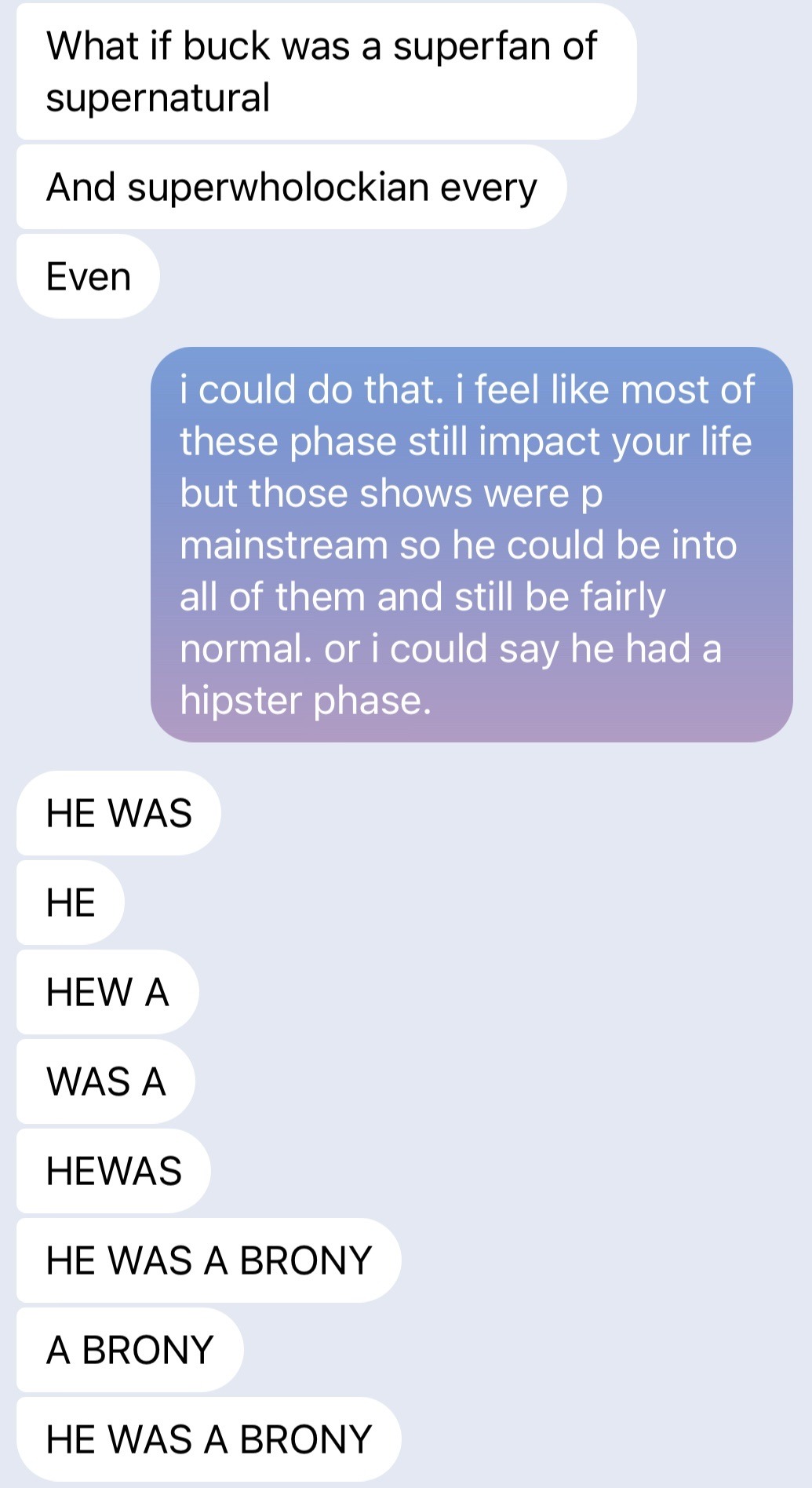

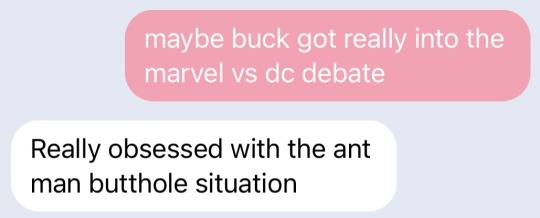
I do feel like being into Supernatual is one of the most realistic options so far lol because like kinda does fall in line with his whole survivalist shtick in a way. It's like hyper-masculine to the point of wrapping around to being camp gay. It was on air for like 15 years or whatever so def while Buck was a teenager.
Honestly, I could say Buck got into that lol so random/rage comics/bacon and mustaches on everything internet culture because. let he who didn't XD cast the first stone.
I will take input if anyone has any ideas on this bc I think it is a fun conversation lol
18 notes
·
View notes
Text
I said I would make art, and by god did I do just that (for once)

Here's a little armadillo friend!! I don't know why my mind was immediately set on armadillos when I was looking for something to sketch, but I do know better than to question - t h e m i n d - *insert ominous music*
Now that I think about it, it's probably because we just got armadillos in minecraft lmao
I think he turned out pretty cute! The paws were really fun to put on paper, lots of big, swoopy lines which I love :]
I'm trying to build up some more confidence when it comes to inking, so I forced myself to ignore my anxiety and actually picked up my fineliner for once, instead of just leaving it as a pencil sketch lol
It was really satisfying to see the scales start to pop out from the page, and adding all of the final details in white gel will always be the best part of any art-session (especially all the little hairs on this dude's shell, that was so gratifying) 😌👌
I'll definetly be turning to armadillos more often in the future when I'm looking for sketch material, these funky little guys have so many fun textures, and their cuteness-levels are through the roof TT^TT<3
With all that said, I hope you have a wonderful rest of your day! ^-^
Yours truly, Stickbug 🪲
#Art#Artist#artwork#traditional art#traditional drawing#sketchbook#cute#animals#Armadillo#he's just a little guy#Stickbug's art :]
8 notes
·
View notes
Text
Transcript Episode 83: How kids learn Q’anjob’al and other Mayan languages - Interview with Pedro Mateo Pedro
This is a transcript for Lingthusiasm episode ‘How kids learn Q’anjob’al and other Mayan languages - Interview with Pedro Mateo Pedro’. It’s been lightly edited for readability. Listen to the episode here or wherever you get your podcasts. Links to studies mentioned and further reading can be found on the episode show notes page.
[Music]
Gretchen: Welcome to Lingthusiasm, a podcast that’s enthusiastic about linguistics! I’m Gretchen McCulloch. I’m here with Dr. Pedro Mateo Pedro who’s an Assistant Professor at the University of Toronto, Canada, a native speaker of Q’anjob’al, and a learner of Kaqchikel. Today, we’re getting enthusiastic about kids acquiring Indigenous languages.
But first, some announcements. We love looking up whether two words that look kind of similar are actually historically related, but the history of a word doesn’t have to define how it’s used today. To celebrate how we can grow up to be more than we ever expected, we have new merch that says, “Etymology isn’t Destiny.” Our artist, Lucy Maddox, has made “Etymology isn’t Destiny” into a swoopy, cursive design with a fun little destiny star on the dot of the eye, available in black, white, and my personal favourite, rainbow gradient. This design is available on lots of different colours and styles of shirts. We’ve got hoodies, tank tops, t-shirts in classic fit, relaxed fit, curved fit – plus mugs, notebooks, stickers, water bottles, zipper pouches. You know, if it’s on Redbubble, we might’ve put “Etymology isn’t Destiny” on it.
We also have tons of other lingthusiastic merch available in our merch store at lingthusiasm.com/merch. I have to say, it makes a great gift to give to a linguistics enthusiast in your life or to request as a gift if you are that linguistics enthusiast.
We also wanna give a special shoutout to our aesthetic redesign of the International Phonetic Alphabet. Last year, we reorganised the classic IPA chart to have colours and have little cute circles and not just be boring grey lines of boxes and to even more elegantly represent the principle that the location of the symbols and rows and columns represents the place and degree of constriction in the mouth. I think it looks really cool. It’s also a fun little puzzle to sit there and figure out which of the specific circles around different things stands for what. We’ve now made this aesthetic IPA chart redesign available on lots more merch options, including several different sizes of posters from small ones you can put on a corkboard to large ones you can put up in your hallway. They look really, really good, especially if you have some sort of office-y space that needs to be decorated. Plus, it’s on tote bags and notebooks and t-shirts. If you want everyone you meet to know that you’re a giant linguistics nerd, you can take them to conferences and use them to start nerdy conversations with people.
If you like the idea of linguistics merch but none of ours so far is quite hitting your aesthetic, or if there’s an item that Redbubble sells that you think one of our existing designs would look good on, we’ve added quite a few merch items in response to people’s requests over the years, so we’d love to know where the gaps still are and keep an eye on lingthusiasm.com/merch.
Our most recent bonus episode was a behind-the-scenes interview with Sarah Dopierala, who you may recognise as a name from the end credits, about what it’s like doing transcripts from a linguistics perspective and her life generally as a linguistics grad student. You can go to patreon.com/lingthusiasm to get access to all of the many bonus episodes and to help Lingthusiasm keep running.
[Music]
Gretchen: Hello, Pedro, welcome to the show!
Pedro: Hello. Thank you so much for this invitation. I really appreciate it.
Gretchen: We’re really excited to have you. Let’s start with the question that we ask all of our guests, “How did you get interested in linguistics?”
Pedro: That’s an interesting question. I think there’re two main things. One is that I had the opportunity to attend a boarding school where there were many Mayan languages and, in addition to that, there was a class on grammar of Mayan languages, and I think that’s one of the things that motivated me to be curious about that language. Then after becoming an elementary school teacher, I was also interested about knowing more about how these languages work. For example, how language works in this case – well, in the case of Guatemala, for example, people think – I am assuming that that was in the past, but there’s, I think, some people who still think that Indigenous languages don’t have a grammar from there as well. Is it true that, in fact, there’s no grammar of this language? That’s kind of how I started –
Gretchen: There’s no language with no grammar.
Pedro: That’s true. I like when people say that everybody has a mental grammar. I like that. Which is true for every language as well. It’s how I would say I got interested in linguistics.
Gretchen: And you’re already a speaker of Q’anjob’al, and so going to this boarding school and being exposed to other people speaking other languages.
Pedro: Also, I acquired Q’anjob’al when I was a kid. And then I went to this boarding school. But unfortunately, I didn’t know any of those languages until later when I started living with my wife who is a native speaker of Kaqchikel, and from there I started to learn, but it has been a long process for me.
Gretchen: To learn different ones. So, you were at boarding school, and you’re encountering, “Okay, Mayan languages have grammar – great!” What happened after that?
Pedro: When I graduated from this boarding school, I became an elementary school teacher. I taught, I think, a couple of years. But one thing that I noticed is that there was that need to understand a bit more of the language. I thought, well, this is something that one of my best friends, who is Eladio Mateo Toledo, he said, “Well, let’s find someplace to go.” We went to school in Guatemala City to study sociolinguistics at that time. I’m talking about years ago. But it was a way to find opportunities to learn a little bit more about the languages.
Gretchen: So, you studied sociolinguistics in Guatemala City and thought, “Oh, this is cool. I wanna do more of it”?
Pedro: I finished sociolinguistics, and then I received a fellowship or a scholarship in a different university. It’s Universidad Rafael Landívar. There was this project called “EDUMAYA” where there were scholarships to Mayan speakers or Indigenous speakers in Guatemala. This was an opportunity for me to get an undergrad in linguistics. After that, I think I took two or one year off, but while I missed those years from school, I was working at OKMA – Oxlajuuj Keej Mayab’ Ajtz’iib’ – under the direction of Nora England.
Gretchen: What is this organisation?
Pedro: This organisation works on Mayan languages. It’s a group of Mayan speakers who studied their own language.
Gretchen: That sounds great.
Pedro: It was really great. In that case, I was an elementary school teacher, and then I started to work very hard at OKMA. It was a huge difference teaching kids and then doing analysis on a language. For me it was a big transition, but it was amazing because I had the opportunity to learn many things about how Mayan language work. It was unique.
Gretchen: And the kids that you were teaching when you were teaching in school were Mayan kids as well?
Pedro: Yeah, most of them were Mayan kids, so they spoke Q’anjob’al. Even though there is this idea about bilingual education in these Indigenous communities, I had this opportunity to teach these children in Q’anjob’al. One of the norms of education is you teach these kids, and they have to learn Spanish and something like that. So, what I did is, okay, let’s take as the base the knowledge that they bring from home. They speak the language, they understand the language, so we need to teach them how to write and read. That’s what I did. I was in trouble because the parents didn’t like the idea of teaching the children in Q’anjob’al.
Gretchen: They wanted them to learn Spanish.
Pedro: Exactly. They said, “Why do we need Q’anjob’al? Why do we need to write when we speak the language?” One of the arguments I made is, okay, yeah, but we need something already that will help us to learn to write and read. It took me a while. One way to convince the parents to change their mind was that, in the first meeting when they came in to get their children’s grade, I started the meeting in Spanish. I messaged them in Spanish. It didn’t last for a minute, and they stopped me. They started to complain and say, “Why would you talk to us in Spanish when, in fact, you know that we speak Q’anjob’al?” Different people, they were angry or uncomfortable because of that. After that, I asked them this question, “Have you thought about your children who spend about five or six hours every day here at school?”
Gretchen: “And if I speak to them in Spanish, they’re not gonna understand me either.”
Pedro: Exactly. That was my point. And this “Oh, yeah, yeah.” “Have you thought about that? Do they complain?” “No.” “Okay, because they are kids.”
Gretchen: They don’t know any better, yeah.
Pedro: For me, it’s important for these children to understand what’s going on in school. One way to do this – using the language that they know. I was able, in this case, to talk with the parents, “Okay, we understand what you are after.” I had the opportunity then to teach the children, at least, I mean, at that time – so divide a year in two parts. In the first part, I would teach the kids in writing and reading Q’anjob’al. And then in the next part of the year, we switched to Spanish. But at least that was an opportunity to –
Gretchen: They have sort of a balance of the two and accommodation of the two, and they’re not coming in and suddenly someone’s talking at them in a language they don’t understand at all – “Okay, what’s going on?” Yeah.
Pedro: Those were the things that I really liked when I go back to that experience that I had as an elementary school teacher.
Gretchen: Then you started doing language work with other linguists and speakers.
Pedro: Yeah. Again, when I came to OKMA, I started working with a group of Q’anjob’al speakers on the dialectal variation of Q’anjob’al. I was there, I think, less than three years. Then I left Guatemala because my wife had a scholarship, and we went to the US. That’s how I started learning English, and then started the MA and PhD programme at the University of Kansas.
Gretchen: In linguistics as well?
Pedro: In linguistics, yeah. Then I started to work on how children acquire Mayan languages – of course, not all Mayan languages, but I started to work on Q’anjob’al to document how these children acquire Q’anjob’al.
Gretchen: Sort of informed by this experience as a schoolteacher saying, “Okay, these kids are coming in already speaking this language. What’s going on?”
Pedro: I think the question is, “What do they know?” That’s how I got interested in this. Plus, at that time I had my first son who was, I think, one-year-and-a-half or something. It was like, okay, this is an opportunity for me to learn how to document child language acquisition. So, then I started to work on Q’anjob’al.
Gretchen: I think there are a lot of linguists who get interested in child language acquisition because you have a child, you’re spending all this time taking care of your child, “What are they doing?”
Pedro: For me, it was really interesting because, again, going back to when we moved from Guatemala to the US, the first time I took care of my son, so I made basically a diary of what he was saying almost every day. I have my notes – I dunno – somewhere.
Gretchen: Then you started looking at other children as well.
Pedro: Yeah. For my MA, for example, I looked at, I think, eight or ten children. It was a cross-sectional study. As for my PhD, I worked on a longitudinal study. My main focus at that time was on how these children acquire the verb morphology in the language, in this case, the word that indicates action, for example, what happens, and then the different parts that are necessary in that verb, for example. We talk about when the action happened, and who is participating in the action. Those are the kinds of things that I tried to evaluate in my study. That’s something that, also, I have been working on these days.
Gretchen: I mean, this is the kind of thing that it’s not like, oh, you study it for one degree, and now you know everything. This is the kind of thing that people could study for a whole career.
Pedro: Exactly. That’s an interesting point because what I have learned is that, okay, I’m going to – so my advisor said, “Well, you can start with this.” And I said, “Well, okay.” I started studying acquisition of the verb morphology, I think, more than 10 years ago. And I thought, “Well, I am done.” It’s not true! Because every time I look at the data, and I find other things, and I start asking other questions. There is no end of that – which is a nice thing that you start with something small –
Gretchen: You’re not gonna be out of a job.
Pedro: It’s nice. I think one thing that I really appreciate is the opportunity that I have also in documenting acquisition for Mayan languages. For example, I have documented the acquisition of Chuj, another written Mayan language to Q’anjob’al, for example. By looking into a known language, it helps me to understand what must be going on in Q’anjob’al. And I said, “Wow! I wish I had access to this language before so I could have a better idea of how to explain what was going on.”
Gretchen: You can find some things that are similar between Chuj and Q’anjob’al, and some things that are different, because the languages are grammatically, you know, related. They’re similar.
Pedro: That really helped in terms of analysis, in terms of understanding what’s going on, in terms of explaining a specific phenomenon, for example. It really helps to have that kind of mirror, for example, to see what’s going on.
Gretchen: One thing that I know about when kids are acquiring English is they often make mistakes. They’ll say things like “runned” instead of “ran” or something like that. This tells you “Oh, they’re generalising something about a rule.” Are there some things that come up with mistakes kids make or interesting things that kids do when they’re acquiring –
Pedro: That’s an interesting question. That’s something I was looking at, for example, for Chuj and for Q’anjob’al is that, so in Mayan languages, for example, there is this suffix that is known as the “status suffix” that appears after a verb. The idea of this status of something, like, it’s indicating what information is provided by the verb.
Gretchen: “Style” suffix?
Pedro: “Status.” “Status suffix.” It indicates whether the verb is a transitive verb or an intransitive verb. In this case, when we talk about intransitive verbs, it’s one participant of the verb. Transitive verb – two participants.
Gretchen: So, if you have something like “walk,” it’s gonna be intransitive, and it’s gonna have one status suffix. If you have something like, well, the classic example is “hit,” but I always find that very violent – you know, “hug” or something – that’s gonna be transitive. And it’s gonna have a different suffix.
Pedro: A different – yeah. In English, for example, that’s just one form of the verb. But in Mayan languages, or someplace, you have a specific morphology on the verb to indicate that, well, you are talking about an intransitive verb or a transitive verb.
Gretchen: So, if it’s just “I eat,” it’s gonna have one status suffix. If it’s “I eat an apple,” it’s gonna have a different status suffix to indicate that that’s there. Okay.
Pedro: I think, trying to answer your question, that all of this – I mean, there are all things that happen with this status suffix, but I haven’t seen children, for example, producing errors with these status suffixes. One thing that we have seen as maybe “errors” or children overgeneralising is the production of the status suffixes in a specific position. One thing that we know about status suffixes is that sometimes they appear at the end of a verb, and other times, they don’t. But in other times, they do. Then the question is, “What happened?”
Gretchen: And adults know this?
Pedro: An adult knows. But for a child, there are different variations on these status suffixes that a child has to find as a challenge. One thing that we notice is that these children, for example, produce these suffixes in non-final position – something that is not seen –
Gretchen: The adults only produce it at the end of the verb, at the end of the sentence?
Pedro: Yes and no. If they have what we call a “root verb” – consonant-vowel-consonant is the idea.
Gretchen: Consonant-vowel-consonant is a “root verb,” okay.
Pedro: When you have that verb with that “shape,” let’s say, that suffix doesn’t appear in the non-final position. But if you have something that is, let’s say, derived, then that suffix has to be there.
Gretchen: Okay. If you make the verb into something else by changing the tense or something –
Pedro: By changing the status of that word. You have the word “song,” for example, and then you make the verb “to sing,” then you add a morpheme to it so that this noun “song” becomes an intransitive. Because of that, then it’s a derived intransitive verb.
Gretchen: It’s a derived intransitive, and you need to have the suffix. Do the kids do this?
Pedro: They produce that. One thing that we noticed is that they make that difference between derived and non-derived intransitive verbs. Again, it’s like they are acquiring that, but that’s what we see as something problematic for them in acquiring those status suffixes.
Gretchen: They have some difficulties still.
Pedro: That’s, I would say, where we see them making those mistakes or having trouble with acquiring the suffixes.
Gretchen: Is there something that you’ve noticed that’s interesting about how kids are acquiring the languages you’ve worked on?
Pedro: In addition to looking at the verb morphology, I also studied how children acquire the nominal classifier – numeral classifier – in Q’anjob’al. In this case, some Mayan languages have a nominal classifier or a numeral classifier. In this language, for example, everything has to be classified. If you refer to a woman, for example, you’re going to use the classifier “ix,” and then “naq,” for example, for men. Then if you have other things like –
Gretchen: You know, a hat or something.
Pedro: Then it would be “chʼen,” for example.
Gretchen: That’s for objects in general, or are there several different kinds of objects?
Pedro: Well, for animals, for people, for objects, and things like that.
Gretchen: So, if you have a dog or something?
Pedro: That’s going to be different. That’s going to be “no’.” I was interacting with this child. He was a boy. Well, first, he was interacting with his grandmother. These classifiers were there. He was like “ix” or “naq” or “chem” or “ch’en” or “no’” – everything that was –
Gretchen: Everything that you would expect for all the different kinds of things that you can refer to.
Pedro: And then someone came to visit grandma. So, grandma left the conversation, so that left just the boy and myself. This is what happened. All of those classifiers were gone. There’s just one that stayed, which is “ix.”
Gretchen: So, he’s using “ix” for everything.
Pedro: “Ix” for everything. But this is not something that he’s just making up. It’s something that we can see in the other grammar.
Gretchen: Okay. Do other children do this as well?
Pedro: Other children do, but mainly boys – not girls.
Gretchen: Interesting.
Pedro: The thing is that this “ix” that replaces all nominal classifiers occurs mainly among men. People have argued that it’s mostly in informal contexts.
Gretchen: Right. So, because his grandma is gone, and you two are men together – well, he’s like, 3 years old.
Pedro: Exactly. It’s kind of like, “Okay, yeah, let’s use the ‘ix,’” replacing the others.
Gretchen: He’s sensitive to the sociolinguistic context of “Oh, women aren’t here anymore, so I’m gonna do this thing” –
Pedro: “With this guy.”
Gretchen: “With this guy.” Even at this young age.
Pedro: Exactly. He was about 2-and-a-half or 3 years old. This boy is able to distinguish both contexts. His grandma has come back in the conversation, and then those classifiers came back.
Gretchen: Wow. He’s really paying attention to this dynamic situation of whether his grandma is here or not changing how he talks.
Pedro: When to use all the classifiers and when to use just one classifier. For me, again, that’s a way to illustrate that these children, they’re exposed to the language, and they are exposed to this system of the nominal classifier, but in addition to that information, the social aspect of that nominal –
Gretchen: And the cultural context where if you just had kids who are trying to learn language in a classroom while maybe the teacher is a woman, and you don’t have all the different types of social situations.
Pedro: One of the things that’s important to emphasise, then, when we do language documentation is making sure that that interaction with that child doesn’t happen only with grandma, for example, but happens with the different gender – I mean, in this case, female/male, and also –
Gretchen: Ages.
Pedro: And there’s ages and the kids themselves.
Gretchen: Because maybe the kids are talking differently with each other than they’re talking with their grandparents or their aunts and uncles or the older generation. The researcher doesn’t necessarily know in advance which things the kids are gonna be paying attention to because maybe the kids don’t learn how to talk like the men until they’re older. You don’t know what age they learn that until you’re studying it.
Pedro: Exactly. I would say the take home message in this part of the conversation is documenting everything, basically, because you never know, I mean, what you will learn. I mean, you never know what will come with this child’s interaction.
Gretchen: I think sometimes when we’re analysing how kids talk, at least a lot of the studies that I see on big languages like English, they bring the kid and maybe one parent, the mom or something, into a lab and they have them talk in this controlled but also very artificial environment. You don’t have the environments of, “Well, somebody comes to the door, so grandma has to go answer the door” that lets you have this situation where you can illuminate this effect. Sometimes, if you do too much control, you don’t actually see the natural things that happen.
Pedro: That’s the difference that we see, I mean, in this case between doing an experimental study and a naturalistic setting, for example. I think when you do certain things in that natural setting, then you have the opportunity to see the language being used in different contexts, for example. In this case that we are discussing for the “ix,” I think it’s a unique illustration of the importance of documenting the language as a whole.
Gretchen: In the whole community, cultural context. I mean, of course, then you also have the thing of like, “Oh, if there’s some birds in the background or something.”
Pedro: Again, that’s the advantage and disadvantage of doing this kind of work. I think it’s good to do both, especially when we talk about Indigenous languages. You mentioned something important, “Okay, what do we know, for example, about language acquisition?” I think most of that information comes from the well-known languages. What happens to these less studied languages or languages that haven’t been studied at all, for example – how to bring those languages into discussing what we learn about language acquisition?
Gretchen: And there’s two reasons why that’s really important. One is because, for speakers of those languages, if they want to try to support using them in schools or using them in daily life or trying to revitalise a language that’s become less common in daily life, having the knowledge of “How do kids talk in this language? What are their first words like? How do adults normally talk to children in a bit of a different style?”
Pedro: I think we can say that it’s not just about the grammatical aspect of the language that these kids are acquiring, but at the same time, how they are acquiring that language, for example. I think one thing that it would be good to connect with language revitalisation is, like, let’s learn the language thinking like we are kids. Because a kid, for example, wouldn’t think about “Oh, is this the way to say it?” “Should I put this here?”
Gretchen: “Should I put this suffix on this verb?”
Pedro: Exactly.
Gretchen: Kids don’t know what a suffix is.
Pedro: And it takes time for them to get to the production of the adult level. For instance, also the sound system that these children produce. Q’anjob’al, for example, has retroflex sounds like /ʈʂʰ/ or /ʈʂʼ/, for example, /ʂ/. And these kids do not produce them like –
Gretchen: They can’t produce them immediately.
Pedro: No, no, no. It takes time for them. I will say three-years-and-a-half or four. It takes that time to produce this retroflex. I think when we are in the context of revitalisation, those learners of a language will go through similar patterns of acquisition.
Gretchen: If you’re trying to re-learn Q’anjob’al as an adult and being stressed that you can’t produce the retroflex and say, “Look, it takes the kids four years. If it takes you four years, that’s really normal. You can keep practicing this and get better at it. If you can’t do it on the first day, then you still have hope.”
Pedro: That’s the importance of doing this kind of project and documenting how children acquire this kind of language. Then this information can be useful for other purposes.
Gretchen: Q’anjob’al also has the ejectives, which I’m not doing a very good job of pronouncing, but you’ve been saying it in the name of the language itself that “Q’anjob’al.”
Pedro: /qʼanxobʼal/, yes.
Gretchen: Do kids learn those really early, or are they a bit harder?
Pedro: It takes time for them as well. That’s another interesting question because what we have noticed is that these children, when they try to produce these ejectives, they would follow two strategies. One – either they produce the plain consonant.
Gretchen: So /kanxobal/ instead of /qʼanxobal/?
Pedro: Exactly. Or they would just produce the glottal stop.
Gretchen: Oh, okay, so /ʔnxobal/?
Pedro: Or something like /ʔanxobal/, but I’m just making this up. It will be something like this – either they use a plain or this glottal stop. It’s a process.
Gretchen: Extracting the two possible features that you would need to put together eventually.
Pedro: This has been reported for the acquisition of sounds in K’iche’ and Chuj, and I also see it in Q’anjob’al.
Gretchen: These are all Mayan languages that have –
Pedro: Mayan languages that have ejectives as well. Maybe someone will say, “This is our dialectal variation,” or “It’s just the kids,” I mean, because of individual differences, but no, it’s across –
Gretchen: It’s across a bunch of them. That gets us to the other reason why it’s really important to document kids acquiring lots of different languages – Indigenous languages – is that, when we’re trying to think, “What do we think about how kids learn language in general?” if we base those theories entirely on a few big languages that have other relatively similar typological features in some cases – English and Spanish are typologically related, and so if you’re coming up with a theory just based on English and Spanish, well, you know, that’s not very generalisable.
Pedro: That’s true. I think that’s one of the other things that we wanted to mention here, like how to include other languages to understand human language and also how these children acquire languages – human languages in the world, you mentioned, that sometimes haven’t been explored at all. It would be good to document those languages and have a better idea of what these kids do. But the other thing that I’m going to add here is that, yeah, we want to have a better idea of how these children acquire language, but at the same time, how this information can be used, again, for language revitalisation or for language maintenance or things that the community’s interested in. One thing that I noticed, for example, about this in Q’anjob’al is that these children, their first words have a basic shape which is consonant-vowel-consonant. This is really common in the whole Mayan languages, but these are the specific things that these children produce. If that’s the case, then is this information possible to use when we consider creating teaching materials for these children? It would be a good thing to have this because it’s going to be much easier if these children can read these words with this shape, for example.
Gretchen: Right. If you know what words they’re acquiring early, then you can say, “Oh, well, we’ll put those words in maybe the first books that we’re trying to have them learn because you don’t wanna try to have them read a book with words that they don’t understand, they’re not using already. You can use this small shape – because Mayan languages have, you know, quite a bit of prefixes and suffixes and things on the words but, of course, you have to start somewhere, and that’s just with – the roots are generally consonant-vowel-consonant, so they just produce the root first, and then they start adding things onto it.
Pedro: Exactly. They are good at identifying those roots in the input or in the adult grammar in this case, yeah. Also, I had the opportunity to collaborate with other people about trying to understand how these pieces are put in the verb. What we have noticed is that there’s the root, and then children are good at producing suffixes.
Gretchen: Ah. But not prefixes?
Pedro: Not prefixes, but for a reason.
Gretchen: What’s that?
Pedro: Stress.
Gretchen: Oh.
Pedro: Stress is also with these suffixes. You have the root and then the suffix.
Gretchen: And that’s the part they do first, and then they do the prefixes much later.
Pedro: Yeah, later.
Gretchen: Interesting.
Pedro: That’s the other thing that we have.
Gretchen: So, you work at the University of Toronto now.
Pedro: Yes.
Gretchen: What sorts of projects are you working on there?
Pedro: Well, my position is about language documentation and language revitalisation. One of the projects that I am currently working on is about the revitalisation of Itza’, another Mayan language spoken in Guatemala, in the northern part of Guatemala, in Petén. It’s a language that has been considered an endangered language because it has less than 40 speakers.
Gretchen: Wow. Less than 40.
Pedro: And most of them are elders. I think this week I was asked about how old is the youngest, and I said, “Well, 70-something.” Children are not acquiring that language anymore. But the goal in this project is how to teach the language and how to bring the language back. That’s one of the projects that I am doing – how to do that. One thing that we are doing with the community is two main things, 1.) is developing a workshop on teaching them how to teach the language.
Gretchen: Right. Because just because you can speak a language doesn’t mean you know how to teach it.
Pedro: That’s one of the things that we did. What would be the best method? We’re using a method that has been used in other contexts, so let’s try to use this for the revitalisation of Itza’, in this case, not for all Mayan languages, but for Itza’ because of the condition of it.
Gretchen: Because Q’anjob’al still has lots of speakers.
Pedro: Lots of speakers, yeah, so it’s different from Itza’. So, that’s one thing. The other thing we are doing – and for me this is really important because we are developing pedagogical material that we are using for the same purpose, but the unique thing for this grammar is that we have students at the University of Toronto who are involved in creating information about the grammar. In this case, these students are doing research about the subject of Itza’, but because they are preparing this material for non-linguists, for example, it’s an opportunity for them, okay, they have to understand the structure of the language but then how to share that information with people who are not linguists.
Gretchen: Who wanna become speakers and don’t have background in grammar or any of these theoretical concepts, but they just need to know how to talk to people.
Pedro: For me, these students have this opportunity to learn to speak the language and then also the opportunity how to share that information with these people, but in addition to that, having the opportunity to work with Indigenous communities and also doing language revitalisation.
Gretchen: And trying to accomplish the community’s goals rather than, okay, I have this research agenda, I’m just gonna show up, extract some information, and then go off and get a degree and have a career without benefitting the community.
Pedro: I think that’s something that I tried to tell the students. Okay, it’s good that you are learning this. You’re doing your research. But at the same time, this is the impact that you are making with your work. Maybe you cannot see it now, but later, you will realise, “Oh, this is what” – it takes time to understand what you are doing. Again, I consider this as an opportunity for the students to be involved in this situation. The other part is, in addition to the workshop on teaching methods, we are also working with community members about the different lessons that we are putting into this grammar. How can we do this? Or how do we do this? Or how do we say this? Basic expressions.
Gretchen: So, if you wanna have a lesson about foods, you wanna make sure you’re using the foods that are in the local area that they wanna be able to talk about not some sort of food that nobody’s actually eating in this place.
Pedro: Exactly. But again, just by doing that, it’s a long process. It has been a long process. We have been working on this grammar, I think, more than a year, and we are not even done. But still, that is helping us to understand how to work with the community, but at the same time, how to work with the elders who have the knowledge of the language, for example. I was telling some of the colleagues a while ago saying that, okay, I was asked whether this pedagogical grammar will be going on under review. I said, “Well, it’s going under review at the moment with the elders.”
Gretchen: Right. It’s not necessarily going under peer review by academics, you’re having the true experts, which is the elders, look at it and say, “What do we think? Do we think this is a reasonable reflection of our language?” How is it like for you as a speaker of a different Mayan language to go into a different community? Do you think this makes it complicated for you or interesting?
Pedro: It’s really interesting for me because I always consider this as an opportunity to work with another group of Mayan speakers but also an opportunity to help them because, I mean, as Mayan speakers or as Indigenous speakers, for example, we go through the same situation. For me, it’s really important to consider that. But I also feel like I have built this good relationship with them and to work in this project. But one thing that I would like to mention is that even though I am a Mayan speaker, even though I am from Guatemala, one thing that I have tried to emphasise is like, showing respect for them. Again, they are different cultures. I mean, we’re Mayan, but our way of living is not the same. I think I try to respect that, like, yes, I am from there, but that doesn’t mean I have impulse things.
Gretchen: It doesn’t mean you know everything already.
Pedro: No, no, no, no. I always say this – I am also learning with them. I am helping. We are developing this project. But we are learning together. That’s the approach I take when working on these kinds of projects.
Gretchen: And you’re also coming in with the backing of a big Canadian research institution and this sort of stuff which puts you in a different situation.
Pedro: I think it’s a lot of responsibility. I think one thing that I am learning is that, yes, we have to do language revitalisation, but I think there’s another component that we have to consider that’s about the research aspect of that. One thing that I noticed about what I am doing is working in the infrastructure of the project, building that relationship, working with elders, working with the different activists in the language, for example. I think that’s the first step. Now, we are doing this, but as for research, you asked me, I don’t have much to say, but again, I think building that infrastructure, it takes time. But if I try to think a little bit more, I would say, well, we have some results of this project. I could mention two. One of them is that we have trained some speakers of the language about the teaching method. They are using this method to teach the language. We are about to finish up this pedagogical grammar for the language. I think those can be considered as “results.”
Gretchen: That’s balancing the way that you have to talk to funding agencies and universities and these bodies that care about results that you can report in a list somewhere while also saying, “Okay, but we actually care about the results that the community members care about, which is having more people able to speak the language,” which is not actually what the research institutions are trying to fund. So, there’s lots of different people who have different priorities that you’re trying to balance between.
Pedro: But for me, that’s an opportunity of how to communicate those ideas and how to make that balance. Sure, research will come. Research will grow.
Gretchen: But the relationship –
Pedro: But the question, “Is it easy to start?” It will take a little bit of time. I think one of the things I would like to mention here, a “keyword,” I would say, is to be patient. Sometimes, we want to see really fast.
Gretchen: Results really fast, yeah.
Pedro: It takes time, yeah. That’s one thing that I see. I also see that this project will grow, and I think there will be more students who will be more interested in working in the project. That’s my hope.
Gretchen: I hope so, too. If people wanna know more information about Q’anjob’al or Chuj or any of the other research that’s being done on Mayan languages, is there somewhere where they should start for more information?
Pedro: I think if you are interested to know more about, in this case, the work that I do, I would recommend exploring my personal website. You can go to linguistics, the University of Toronto, and then you will find my personal website.
Gretchen: We’ll link to that from the description as well so people can follow that for more information.
Pedro: Thank you.
Gretchen: If you could leave people knowing one thing about linguistics, what would that be?
Pedro: That’s a good question. I would like to say the following – when you do linguistics, it’s good to start with something small. It’s good that you start with that something small and then start asking questions that maybe you don’t have answer to that question, but you will find answers to that question. I hope I can connect that or relate that to what I mentioned in the discussion that we had today. Remember, I said that I started studying the verb in Q’anjob’al – and I am not done exploring that. Start with something small. But the other thing is that, yes, as a linguist, for example, or as a researcher, you have your own agenda, but try to reflect a little bit about, also, the community’s agenda and the community’s needs. I think that’s important to have that in mind and also important for you to build a relationship with that community that you are working with.
[Music]
Gretchen: For more Lingthusiasm and links to all the things mentioned in this episode go to lingthusiasm.com. You can listen to us on Apple Podcasts, Google Podcasts, Spotify, SoundCloud, YouTube, or wherever else you get your podcasts. You can follow @lingthusiasm on Twitter, Facebook, Instagram, and Tumblr. You can get redesigned IPA posters, “Not Judging Your Grammar, Just Analysing It” stickers, t-shirts that say, “Etymology isn’t Destiny,” and other Lingthusiasm merch at lingthusiasm.com/merch. I can be found as @GretchenAMcC on Twitter, my blog is AllThingsLinguistic.com, and my book about internet language is called Because Internet. Lauren tweets and blogs as Superlinguo. Our guest, Pedro Mateo Pedro, can be found at pedromateopedro.ca. Lingthusiasm is able to keep existing thanks to the support of our patrons. If you wanna get an extra Lingthusiasm episode to listen to every month, our entire archive of bonus episodes to listen to right now, or if you just wanna help keep the show running ad-free, go to patreon.com/lingthusiasm or follow the links from our website. Patrons can also get access to our Discord chatroom to talk with other linguistics fans and be the first to find out about new merch and other announcements. Recent bonus topics include an interview about what it's like to transcribe all of the Lingthusiasm episodes as a linguist, using linguistics in the workplace beyond academia, and a very special Lingthusiasmr bonus episode where we read The Harvard Sentences to you [ASMR voice] in a calm, soothing voice. [Normal voice] Can’t afford to pledge? That’s okay, too. We also really appreciate it if you can recommend Lingthusiasm to anyone in your life who’s curious about language. Lingthusiasm is created and produced by Gretchen McCulloch and Lauren Gawne. Our Senior Producer is Claire Gawne, our Editorial Producer is Sarah Dopierala, our Production Assistant is Martha Tsutsui-Billins, and our Editorial Assistant is Jon Kruk. Our music is “Ancient City” by The Triangles.
Pedro: Stay lingthusiastic!
[Music]

This work is licensed under a Creative Commons Attribution-NonCommercial-ShareAlike 4.0 International License.
#language#linguistics#lingthusiasm#episode 83#transcripts#podcasts#child language acquisition#language revitalization#mayan languages
25 notes
·
View notes
Note
I really like how you draw eowyn could you please do a tutorial or show us tips?
OH. Oh wow! Sure, I’d love to! It’s pretty simple, really.
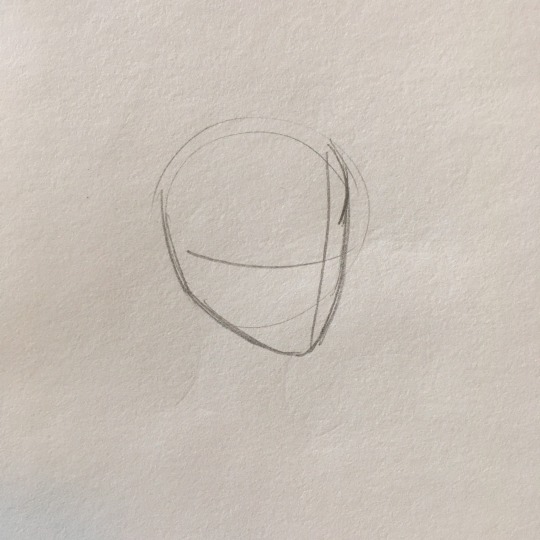
Step One: Get Head. I have a variety of different face shapes that I use to differentiate characters from each other. I can sorta break it down into three categories:
Face height: Long, Medium, or Short
Jaw shape: Triangle, Square, or Circle
Face fat content: Gaunt, Angular, Average, Soft, or Pudgy
Mixing and matching these gets you different face shapes that you can tailor to express the personalities of the characters. Pippin is short + triangle + soft. Aragorn is long + square + angular. Gaunt and Pudgy face shapes are reserved mostly for Gollum and Sam, respectively. Eowyn falls somewhere in the realm of medium + triangle + soft when it comes to her face shape.

Step Two: Silhouette. I’m only drawing her from the shoulders up here, but the principle is the same when I’m drawing the rest of her body too: think long, slender, and no hard angles. Eowyn has a long, slender neck, narrow wrists, and thin fingers. She has a slight hourglass figure, but she has a tiny bust and her hips are not very wide. I try to keep in mind that when she’s wearing armor, she looks indistinguishable from a young man, so even though she’s pretty, her figure isn’t overly feminine.

Step Three: Eyes. I also have a lot of different eye shapes to choose from! Sam, Pippin, and Legolas are Round, Frodo and Aragorn are Slender, Merry and Gimli are Square, and so on. Eowyn’s eye shape is Round but with a little wing on the side to give the impression of thicker eyelashes. (I also realized on this step that I didn't make her cheek round enough, so I fixed that. I'm always making micro-adjustments like that as I draw.)

Step Four: Face. Again, think “long and slender”. Eowyn has a thin little button nose, a small-ish mouth, and very narrow eyebrows. Her ear shape is one of my rounder ones, but only because I think it’s cute.

Step Five: Hair, The Beginning. So this is where the hard part starts. Most of my characters have hair that either covers their forehead (eg. the hobbits) or doesn’t (eg. elves), but Eowyn’s hair does both. It’s also parted on the side, which makes it asymmetrical. I’ll show you how it works from this angle, but I have to get more creative when I, say, draw her from the other side. (I always have to keep in mind the shape of her hair, imagining it as a 3-D object and drawing it as such.)
So here we're gonna draw the bottom outline of her bangs where they sit on her forehead. Pick an “origin point” on the side of her head, where the hairline sits. Make a little jagged squiggle there to represent the roots of her hair. Then one little S-shaped swoop to show where her hair springs out of that point and then goes behind her ear, and a BIG S-shaped swoop up and then down over one eye. These lines form a slight “m” shape—with the “origin point” in the middle—and that makes the hair look like it has volume and lift, as opposed to just sitting flat on her head.

Step Six: Hair, The Second. With the bottom outline covered, let's take care of the top. Again, hair has volume, so it doesn't sit exactly flat on her scalp, but hovers above it in little hills; the closest it sits to her skin is that line where it's parted on the side of her head. I use faint, loose lines here, just trying to capture the flowing, wavy texture. Think Ariel’s hair from The Little Mermaid; you know, with the iconic swoopy floppy bit right in front of her eyes.

Step Seven: Hair, The Third. Eowyn’s hair goes down to about her mid-back, and it’s very thick and wavy, which I portray by using pretty much only S-shaped lines as I draw. It’s impossible to think about the physics of every strand of hair individually, so I’m drawing it in sort of loose “chunks” or “ropes”, keeping in mind how all those “ropes” would interact with each other and the shape of her body that they’re sitting on. You can see that most clearly in the “rope” of hair that lies on her shoulder. There’s no need to think too hard about this, but I always have it in the back of my mind somewhere.
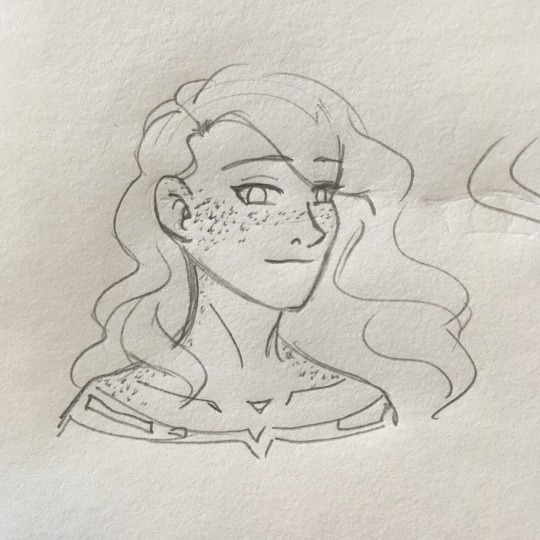
Step Eight: The Frecklening. Now to add some details, including the lines on her neck and collarbone, the off-the-shoulder dress, and a bajillion freckles. She actually has less freckles on her neck than Pippin does—I concentrate it more on her cheeks and shoulders instead—but it’s still a lot, LOL! They are also on the backs of her arms and hands, where she’s most likely to be touched by the sun.

Step Nine: SHADING. This is why it’s important to think of what you’re drawing as a 3-D object, ‘cause you’re gonna have to work out how light interacts with it. There’s a shadow on her neck under her chin, of course, but where this gets really interesting is when it comes to the hair: because she’s blonde, I don’t shade her hair except a) at the hairline and b) on the bottom side of the waves, where shadows would form.
The darkest shading is on the underside of her hair. Think of it like putting a hood on your head while standing under a lightbulb: the outside of the hood gets light, but the inside, next to your head, is in shadow. Similarly, we can see the shadows on the underside of Eowyn’s hair, and especially under the floppy Ariel bangs. Adding that shadow gives the bangs the illusion of volume, which is exactly what I’m going for.
(EDIT: Forgot to mention that when I'm adding shadows to hair, the lines I'm drawing actually follow the path that the hair takes. The shadows on Eowyn's hair swoop and curve and wave because, well...that's what her hair is doing. There are some exceptions when I'll ignore the texture of hair and just shade it in with straight lines of hatching—especially when it's so dark it won't matter much anyway—but for the most part, "follow the texture" is my rule of thumb.)

Step Ten: DONE! A couple more details—including shading where her hair casts a shadow on her skin, and more freckles—and that’s it!
I hope that helps, Anon! I kinda skimmed over the basics here—like why I draw that + shape as a guideline on the face—but I’m assuming you already have some experience in drawing and just want to know the thought process behind my design. Feel free to send another ask if you need to know anything specific! Thanks for asking!
47 notes
·
View notes
Text
i haven't seen seasons 1 through 3 since 2019 (but i am slowly making my way back through it) so forgive me for any inaccuracies, but purely from memory this is how im ranking steve from each season
character in general
Season Two Steve, because he's still got that jock-ish bitchy energy but it's also where we really start to see his softer side and also i think the first time you genuinely feel for him (his problem with billy, his implied problem with school, the bullshit scene), it's also the birth of babysitter steve!! and the second but much more thorough time we're shown that he's fully willing to put his life on the line to protect people he doesn't even know that well. He's a competent and strategic character who definitely has the vibe of Just Trying To Get Through The Year.
Scoops Steve, for similar reasons as the above but we also get to see the goofier prettyboy side of him and we're better introduced to Steve's observational skills and how the fact that he's not "smart" like the others is actually one of his advantages. Because while robin and dustin were focused on translating russian, steve couldn't stop noticing how familiar the background music was. this is also the season where Steve is starting to be written as a ditzier character, but i'm choosing to chalk that up to the fact that he's more laidback and less worried about his public appearance now that he works at an icecream parlor and wears a sailor uniform.
(This is also the most bisexual version of steve, followed by s4)
King Steve, who i personally think was quite shallow (like from a writing perspective) but that is almost definitely because he wasn't originally supposed to survive the first season so he's forgiven for that. Still, we are shown someone who is cutting and self-confident, and then later shown that he is someone who is quick to realise when he's genuinely fucked up and just as quick to apologise. It's also when we're introduced to the idea that he will consciously put himself in danger to protect others. (@peter-pantomime made a really great video about one of Steve's tells on tiktok and i haven't been able to get it out of my head ever since)
Season 4 Steve, because they pretty much erased any and all of the competency previously shown in his character. I think this season did the most disservice to him, seeming to only write him off as genuine idiot who gets treated like shit by all of his friends and is only useful as a babysitter for teenagers who don't want to be babysat. It erased any progress he'd made in regards to his relationship with Nancy Wheeler, i think the only thing that kept him feeling like Steve was Joe Keery's acting and how well he knows the character. I think a lot of what was wrong with Steve's character this season could've been a really great way to introduce the amount of head trauma he's received through the other seasons but considering it wasn't so much as hinted at in canon it just seems like they circled back around to making Steve Harrington's character as shallow as it was in season 1. whether or not that's because they're setting him up to die in season 5, i think it was unfair.
character design
Scoops Steve, in his little sailor outfit with the floofy hair and the lipgloss?? iconic (bonus: the dark blue jeans with the red and blue vest when he applies at family video)
Season Two Steve, with the tight blue jeans and the sunglasses and the swoopy hair and the nail bat, also iconic (bonus: his gym uniform AND the maroon sweater when he drops dustin off at the dance)
Season 4 Steve bc he spent a majority of his screen time shirtless and only wearing a battle vest, and then later the coolest fucking jacket i've ever seen (wait shout out to that blue and white polo shirt that showed off his arms, thank you for your service; and his cute little yellow sweater)
King Steve, while i do love the preppy look and how much it made him look like a puppy at times, what the actual fuck was going on with his hair?? i would have liked to see more of the floppy haired steve we saw when he was helping Nancy study ):
#this was literally just happened because i was arguing with myself in the kitchen#i dont care if you agree with me this is just my opinion on steve ajfhskd#i would like to do one on mike wheeler actually but i'd need to rewatch the whole show first#i only know steves storyline as well as i do bc of the amount of steddie fanfics i've read since july#anyway thank you for reading if you did and also thank you for not reading if you didn't sfjsdhkf#steve harrington
68 notes
·
View notes
Note
In your opinion, what is the worst plot line in the show for some/each of these characters: Luke, Jess, Lorelai, Rory, Lane, Dean and Logan?
Luke=In season 4, Luke begging Jess to forgive his mother and walk her down the aisle at her wedding after how she raised him was baloney. Also the april thing, but it's inconsequential. I don't watch past season 4 anymore.
For Jess, a lot of season 4 was cringy... the running away the first time after saying i love you, then the thing where he was frantically begging Rory to run away with him and honestly he sounded like a crazy person and I don't think it sounded the slightest bit romantic. Rory should have called the police, tbh. lol. But he looked good in that leather jacket and that swoopy hair, boy howdy. Love me some S4 Jess Hair. Hey Tawd!
Lorelai, Logan and Dean's general existence.
Too many injustices were perpetuated against Lane to even count, similarly Rory's too much of a disaster for me to pick just one fucked up thing the writers did with her.
3 notes
·
View notes
Text
here's my ranking of every corvette model purely on aesthetics, from C1 to C8
C1

Obviously, it's old. It looks old. There's essentially zero hard lines, as every piece of it is curved and connects smoothly without any angles. You can see the front-engine design that pushes the cabin towards the rear, which would be the defining visual feature imo for the corvette line as time goes on. Kind of timeless tho.
C2
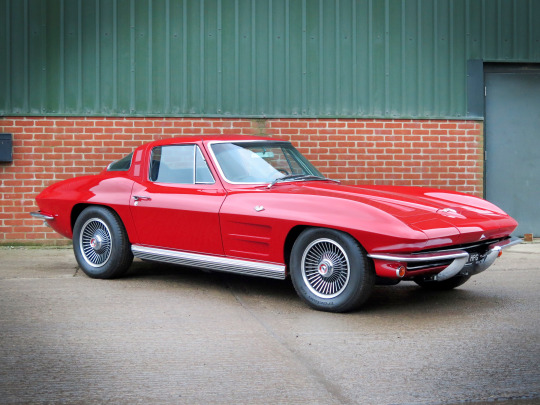
This thing looks space age as fuck. I don't think I would fit in that cabin at 6'2", but they've leaned even harder on pushing the seats back about as far as they could go and giving what looks like fully half of the body, the front half, over to the engine. They've also kept a lot of the swoopiness and smoothness in the design, but you can start to see some hard lines on the side panel towards the front wheel, and an actual honest-to-god angle on the A pillar. I feel like this aged worse than the C1, but that's mostly my personal preference.
C3

Now we're fuckin talking !!! To me, this is some top shelf corvette design. The cabin is pushed back and the swoops are still present over top of the wheel wells, but they've gone for a more aggressive and angular front bumper design and some choice chrome.
C4

Flopp....to me, this is like the catfish camaro; it's kind of neat, but it looks nothing like the rest of the generations. This is like, there's no swoops. Or there is, but it's in the wrong places. They've taken out that gorgeous grille up front and hidden the vents on the side. I don't like it very much.
C5

LETS GOOOOOOO i love this one. Maybe I'm biased cuz this is the model I grew up seeing, but they brought back the smooth flowing curves and reimagined that side panel line from the C2. I wish it was just a touch more angular on the front bumper, maybe even borrowing elements from the C4 design (but ideally C3), but to me this is a huge return to form after the C4 flop. I know it looks kind of weird honestly and it's probably not for everyone, but I like it.
C6
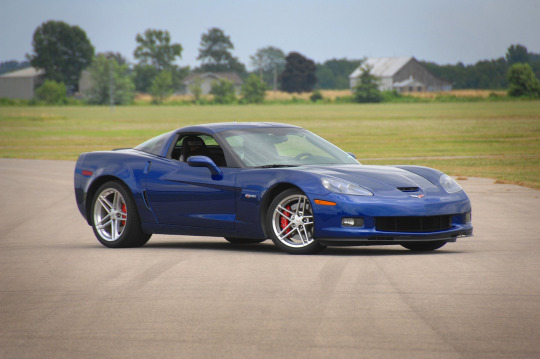
This is textbook, truly stunning, a masterclass in modern corvette design. They dialed it back a bit from the frankly offensive curvature (even though...I love it...I know it's too much for most people) of the C5, and re-incorporated a bigass intake to the front. They've kept the C2, C3, and C4 elements I love and combined them with an evolved C5 chassis to create what is, in my opinion, the greatest 'vette look since the iconic C3.
C7

Ok so bad take maybe but to me the C7 is where we're starting to slip. It looks good, don't get me wrong -- it's angular, it's sharp, it looks mean and fast and all the things you want from an expensive car. But it's starting to look less like a Corvette, to me. There's still the front engine position, but look how much the cabin has crawled forward since the C2. Since even the C5. And where's the swoopies? The curves? This looks kind of like if a Camaro and a Ferrari had a baby -- which is kind of distinctly far from what a Corvette should look like. To me.
C8

And there is it...the C8.
Let me tell you a story. My grandfather, may he rest in peace, owned a C3. It was in brown, which is kind of the worst color, but a beautiful machine nonetheless. And my father, his son, drove it with startling regularity. Can you blame him? If I'd had access to a Corvette in my teen years I would have driven it just to drive it! He loved it so much that he totaled it, and I never got to see it in my own lifetime.
I say all this to say: my dad knows what a Corvette looks like. He spent a huge chunk of time in his formative years driving one. Through my childhood he would often tell me stories, mostly the one of him totaling it, of him driving it. And the first time he saw this car, he asked me what it was.
BECAUSE IT DOES NOT LOOK LIKE A CORVETTE.
The swoops; the long nose; the engine in front of the driver -- even the side vents have been repurposed as additional air intake and shoved way back! If you squint, it kind of resembles the C7. But that's cuz they're lying: that classic bubble cockpit doesn't cover just the seats, but also the engine. This isn't an FR car. This thing looks practically indistinguishable from anything coming out of Maranello.
They've said the C9 is going to be built on the same base as the C8, which is pretty disheartening. I hope once the line switches over to being electric, they're able to make it look more like it's supposed to.
#corvette#i know these opinions are uninformed but#i actually feel pretty strongly about them#corvettes are like the one american car i'd kind of like to drive#since i've never seen a pig in one#and they're not utter dogshit in a corner
2 notes
·
View notes
Text
Art Style Tests!

Featuring Lorge Jestro and Smol Jestro.
I tried to experiment with different styles from my usual one and it was a fun exercise. Definitely helped me see alot of alternative things I could do with my style.
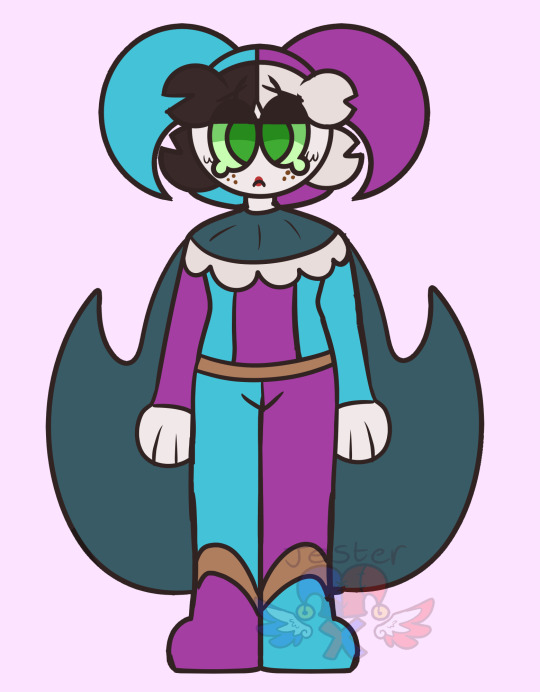
Smol Jestro!
Idk what kind of style this is. I just used the circle tool a lot. I like the simplicity of it tho. He's cute. It's literally just shapes and the most minimal amount of lines. Simple. Very chibi ESC. I like it.
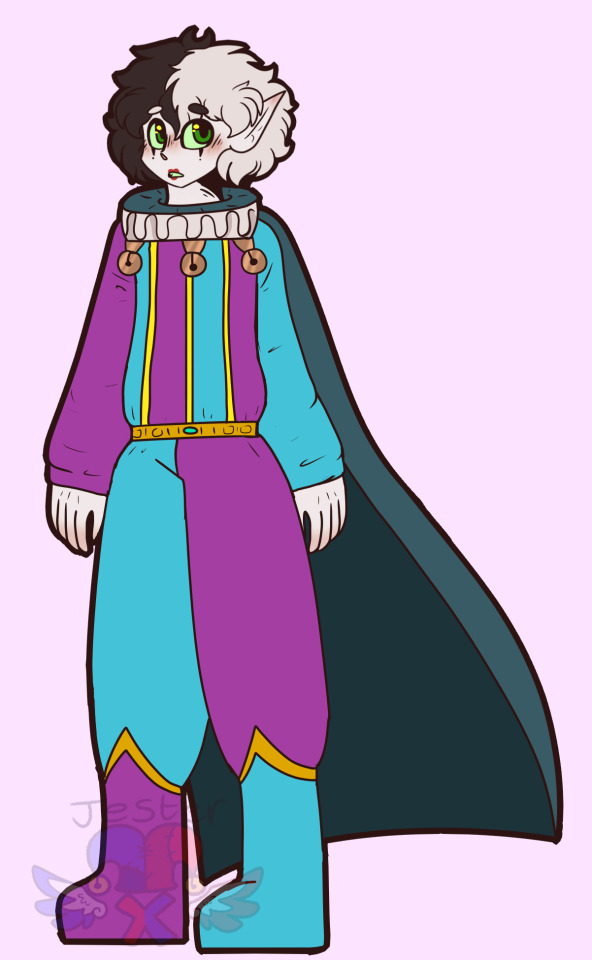
Lorge Jestro!
For this one I tried the more "Detailed" style. I tried to add details I wouldn't add in my regular style and I gave the hair more swoops while also trying better anatomy, different eye size, nose and head shape. Also thinner line art. Also drawing his hat it this style was annoying me and I wanted the swoopy hair to be more shown that's why I'd didn't draw it.
Hope you like em'!
#lego nexo knights#nexo knights#jestro#art#lego#jestro the jester#lego art#art style#art style tests#experimental art#experiment#circle#This was fun but im never doing it again#digital art#fire alpaca#jester#sad clown
53 notes
·
View notes
Text

Cold Male God
Since we're on a roll with figures inspired by Gong Jun's November 2022 Cosmopolitan Magazine photo shoot, let's keep going!
You've already seen Little Farmer Jun, as inspired by this:

As well as Harvest Tomatoes, inspired by this:

So today's fig is inspired by this shot:

I love sitting figs! There's something about the already small size of figs being even smaller and cuter when they're sitting down. Before we get started, here's one more shot from the magazine of this look:

No idea what the print on the sweater he's wearing there is.
The name of the fig, 高冷男神, gāo lěng nán shén, cold elegant male god, is a phrase Gong Jun has used many times to refer to himself before. He has it on his Weibo (fresh screenshot as of today, you can tell by his last post at the Jay Chou concert!):
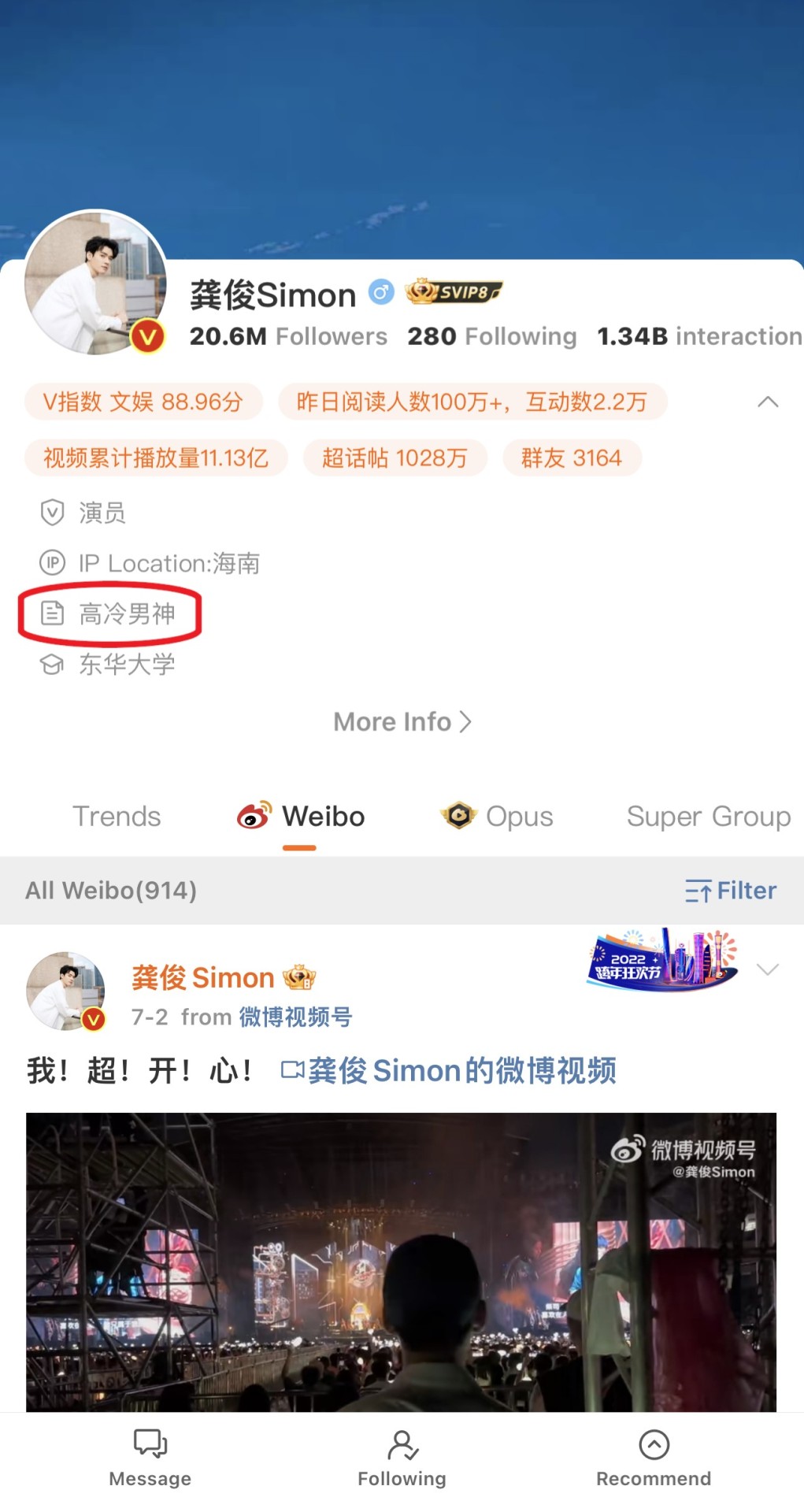
He's also called himself this in situations where he is definitely not at his most glamorous! He posted the phrase with a (now deleted) Instagram post of himself as a smoky and dirty Huo Yan in The Flaming Heart:

He also shouted "Call me a cold elegant male god," after his Happy Camp episode where he had to dress up as Nezha:

The fig maker wasn't nearly as tongue-in-cheek with this fig, and instead took a much more literal approach! I'd say that out of the entire photo shoot, this indeed is probably the most aloof and elegant looking out of them all.
My guess (which is always extremely dicey given my lack of cultural or linguistic knowledge) is that the phrase 高冷男神 isn't that uncommon to use to refer to very handsome men in high fashion. Zhehan's been referred to that way (in his Sensodyne ad), and a quick search shows that it's been used to refer to other good looking men before. May be just an archetype for a certain type of look.

As you can tell! Hahaha, figures this little guy would be completely swaddled up in plastic to protect him. He arrived flawlessly, as only us mere mortals could ever hope to do.
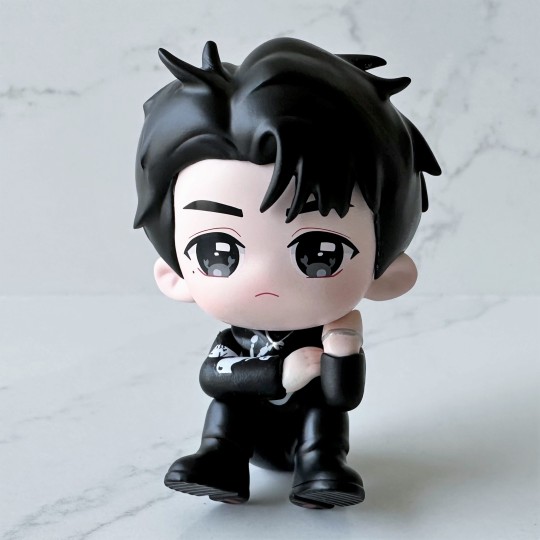
The first thing about this fig that I noticed is of course his magnificent tousled sweep of hair. I love it, it is outstanding. In my opinion, Gong Jun looks best with his hair off his face and with plenty of volume, and the figs do too.

I have no earthly idea what the little creature is in his eyes. It looks like a video game creature almost? I experimented cropping out just that part of his eye and ran a reverse image search, but came up with nothing. Smarter minds than mine, no doubt.
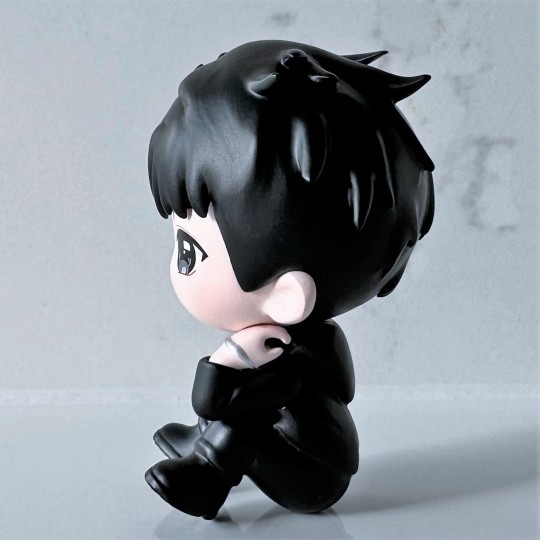
We have his silver Tiffany bracelets here, and his hand artfully curled up by his face.

This fig is resin, but is a lighter type. Some resin figs I have are like bricks, they are so heavy. This fig is surprisingly light - I forget sometimes and think it's PVC.

Wow, look at his hair. Amazing! It's very tousled. I like it a lot.
Despite the narrow body silhouette of this fig, the fig sits up just fine. I don't worry he's going to tip over backwards or forwards. If there was an earthquake or something, though, I'd be concerned that he'd fall over (and maybe break some of those glorious hair tendrils), so he'll go on a fig stand.
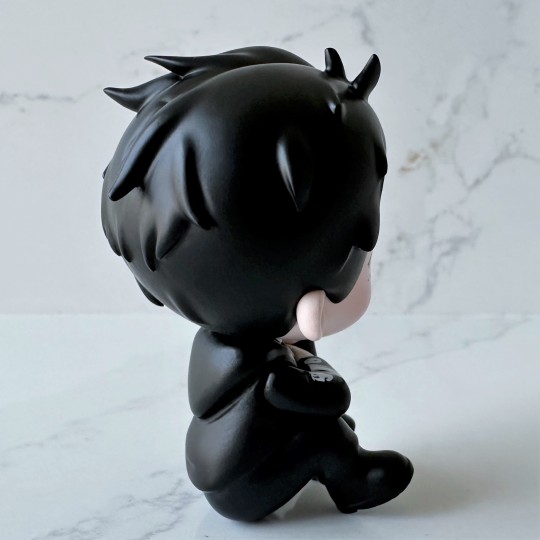
I actually didn't realize in the photo shoot pics that he was wearing a hoodie. I thought it was actually a black hat hanging behind him in the shot where he's sitting on crates. But no, apparently it's just the hood that's been artfully propped up behind his head.

I can't quite make out what the pattern of the sweater is on his arm, but the fig maker worked hard to replicate it!
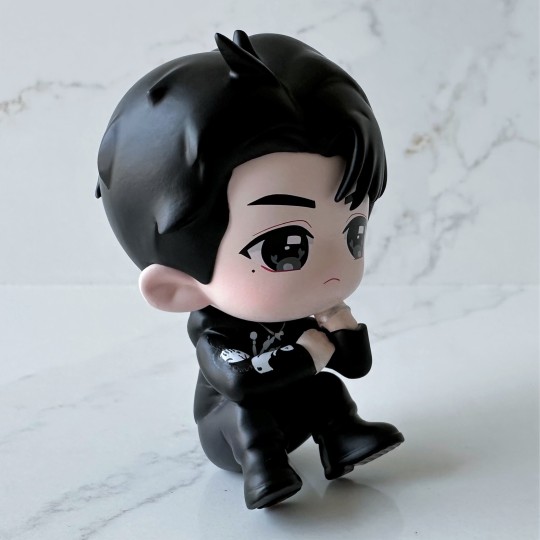
You can see he's very gently propped up there on his boots. Very much in line with the inspiration pic, but also the reason he's going on a fig stand.

This fig is so small and cute! I really do think this is the most impressive and dramatic modern hair style I've seen yet on a Gong Jun fig.

The fig maker even replicated the red branding dots on the soles of his boots!

He's so squinched up from this angle! Looking very small and adorable.
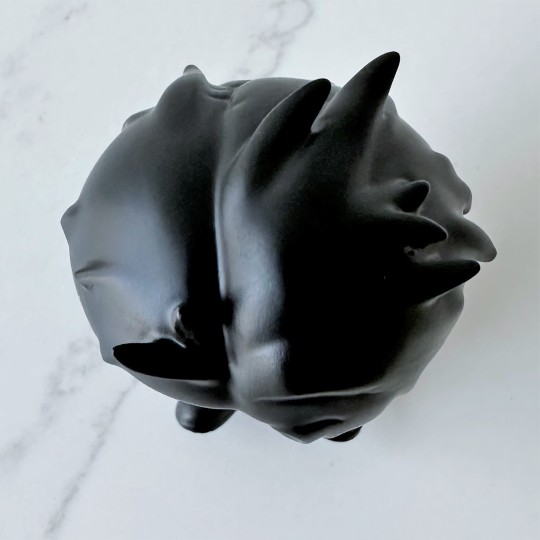
His hair is still impressive from the top down with that big swoopy piece there.

In order to give you an idea of the relative size of this fig, here he his compared to his other incarnations in this series.
Material: Resin
Fig Count: 420
Scene Count: 29
Rating: Cold and elegant model, warm and happy puppy!
[link back to Master Fig Index for more posts]
7 notes
·
View notes